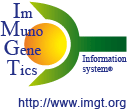IMGT unique numbering for all IG and TR V-REGION of all species:
interest for structure and evolution
In order to easily compare V-REGION sequences of IG and TR from all species, a unique numbering has been defined by Marie-Paule Lefranc [1-6].
The 'IMGT unique numbering' concept is part of the 'NUMEROTATION' concept of IMGT-ONTOLOGY [7]
The IMGT unique numbering for all IG and TR V-REGION of all species relies on the high conservation of the structure of the variable region [1-6]. This numbering, set up after aligning more than 5 000 sequences, takes into account and combines the definition of the framework (FR) and complementarity determining regions (CDR) [8], structural data from X-ray diffraction studies [9], and the characterization of the hypervariable loops [10]. The delimitations of the FR-IMGT and CDR-IMGT regions have been defined and Correspondence between the IMGT unique numbering and the other numberings has been established [6].
The IMGT unique numbering has many advantages:
- It allows an easy comparison between sequences coding the variable regions, whatever the antigen receptor (IG or TR), the chain type (heavy or light chains for IG [4,11]; alpha, beta, gamma or delta chains for TR [5]), or the species.
- In the IMGT unique numbering, the conserved amino acids always have the same position, for instance Cystein 23 (1st-CYS), Tryptophane 41 (CONSERVED-TRP), Leucine 89, Cystein 104 (2nd-CYS). The hydrophobic amino acids of the framework regions are also found in conserved positions. IMGT Colliers de perles of the human germline immunoglobulin IGLV6-57 gene and T cell receptor TRGV9 gene can be chosen as examples.
- This unique numbering has allowed the redefinition of the limits of the FR and CDR. The FR-IMGT and CDR-IMGT lengths themselves become crucial information characterizing the variable regions belonging to a group, a subgroup and/or a gene [4,5].
- Framework amino acids (and codons) located at the same position in different sequences can be compared without requiring sequence alignments [11,12]. This also holds for amino acids belonging to CDR-IMGT of the same length.
- The IMGT unique numbering has allowed a standardized IMGT description of mutations for the IMGT description of allele polymorphisms and somatic hypermutations of the variable regions. The mutations and allelic polymorphisms are described by comparison to the germline V-REGION, D-REGION, J-REGION and to the C-REGION from the IMGT reference directory. Based on these criteria, Alignments of alleles [4,5] and Tables of alleles have been set up.
- The IMGT unique numbering has allowed to set up the IMGT standardized criteria for the statistical analysis of IG and TR V-REGION amino acid porperties [11].
- The unique numbering is used as the output of IMGT/V-QUEST integrated sequence alignment tool which analyzes your IG and TR variable (germline or rearranged) sequences according to IMGT criteria. In IMGT/V-QUEST, a variable rearranged sequence is compared to the appropriate sets of V-REGION, D-REGION and J-REGION alleles from the IMGT reference directory. The results show, aligned with the input sequence, the sequences of the most homologous V-REGION alleles and, if appropriate, D-REGION (for heavy chains) and J-REGION alleles. The aligned V-REGION sequences are displayed according to the IMGT unique numbering and with the FR-IMGT and CDR-IMGT delimitations.
By facilitating comparisons between the sequences and the descriptions of alleles and mutations, the IMGT unique numbering represents a big step forward in the analysis of the IG and TR sequences of all species. Moreover, it gives in-sight in the structural configuration of the variable domain and opens interesting views on the evolution of the sequences of the V-set, since this numbering has been applied with success to all the sequences belonging to the V-set of the immunoglobulin superfamily, including nonrearranging sequences in vertebrates (CD4, Xenopus CTX,...) and in invertebrates (Drosophila Amalgam, Drosophila Fasciclin II, etc.) [1, 2, 9].
| [1] | Lefranc, M.-P., "Unique database numbering system for immunogenetic analysis", Immunology Today, 18, 509 (1997), LIGM:194. |
| [2] | Lefranc, M.-P., "IMGT Locus on Focus:
A new section of Experimental and Clinical Immunogenetics", Exp. Clin. Immunogenet., 15, 1-7 (1998)
PMID: 9619395, LIGM:199
|
| [3] | Lefranc, M.-P., "The IMGT unique numbering for immunoglobulins, T cell Receptors
and Ig-like domains", The Immunologist, 7, 132-136 (1999), LIGM:217
|
| [4] | Lefranc, M.-P. and Lefranc, G., The Immunoglobulin FactsBook, Academic Press, 458 pages (2001) ISBN:012441351X. |
| [5] | Lefranc, M.-P. and Lefranc, G., The T cell receptor FactsBook, Academic Press, 398 pages (2001) ISBN:0124413528. |
| [6] | Lefranc, M.-P. et al.,
Dev. Comp. Immunol., 27, 55-77 (2003)
PMID: 12477501, LIGM:268
|
| [7] | Giudicelli, V. and Lefranc, M.-P., Bioinformatics, 15, 1047-1054 (1999)
PMID: 10745995,
LIGM:221
|
| [8] | Kabat, E.A. et al. in "Sequences of Proteins of Immunological Interest" Public Health Service, NIH, Washington D.C. (1987). |
| [9] | Satow, Y. et al., J. Mol. Biol., 190, 593-604 (1986). |
| [10] | Chothia, C. and Lesk, A.M., J. Mol. Biol., 196, 901-917 (1987). |
| [11] | Pommié, C. et al., J. Mol. Recognit., 17, 17-32 (2004), PMID: 14872534, LIGM:284. |
| [12] | Ruiz, M. and Lefranc, M.-P. Immunogenetics, 53, 857-883 (2002) PMID: 11862387 LIGM:259 |
We thank Elsevier and Developmental and Comparative Immunology, for allowing IMGT to make available the DCI pdf file on the IMGT site.



